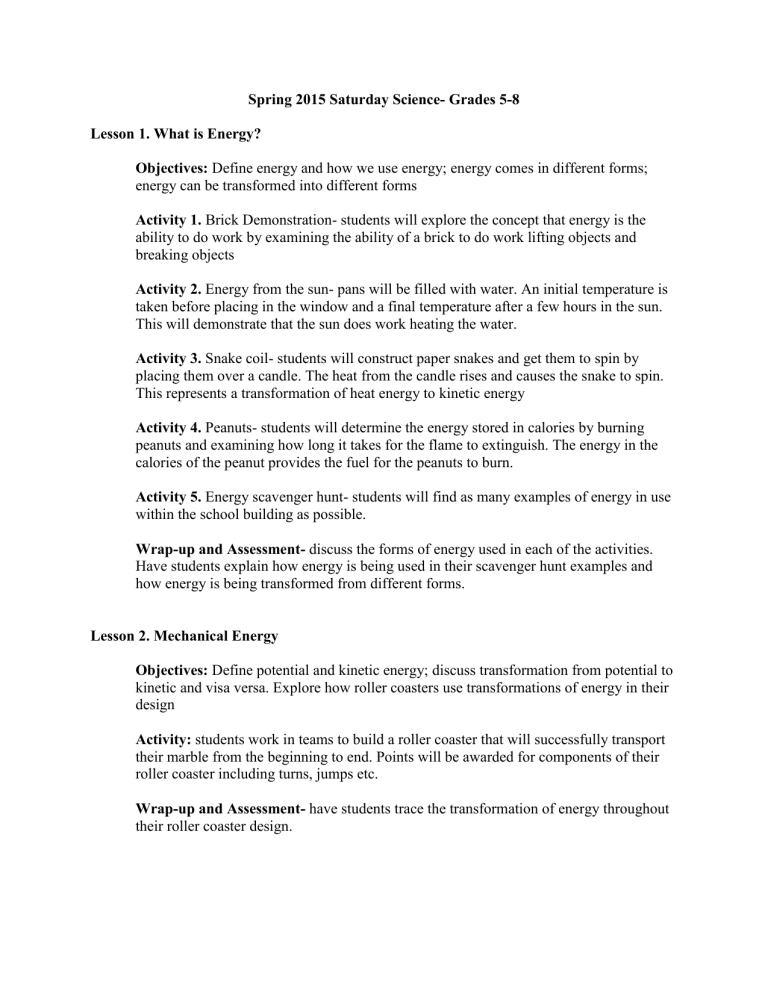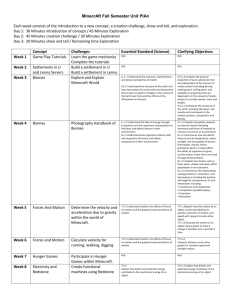Spring 2015 Saturday Science- Grades 5

Spring 2015 Saturday Science- Grades 5-8
Lesson 1. What is Energy?
Objectives: Define energy and how we use energy; energy comes in different forms; energy can be transformed into different forms
Activity 1. Brick Demonstration- students will explore the concept that energy is the ability to do work by examining the ability of a brick to do work lifting objects and breaking objects
Activity 2. taken before placing in the window and a final temperature after a few hours in the sun.
This will demonstrate that the sun does work heating the water.
Activity 3.
Energy from the sun- pans will be filled with water. An initial temperature is
Snake coil- students will construct paper snakes and get them to spin by placing them over a candle. The heat from the candle rises and causes the snake to spin.
This represents a transformation of heat energy to kinetic energy
Activity 4. Peanuts- students will determine the energy stored in calories by burning peanuts and examining how long it takes for the flame to extinguish. The energy in the calories of the peanut provides the fuel for the peanuts to burn.
Activity 5. Energy scavenger hunt- students will find as many examples of energy in use within the school building as possible.
Wrap-up and Assessment- discuss the forms of energy used in each of the activities.
Have students explain how energy is being used in their scavenger hunt examples and how energy is being transformed from different forms.
Lesson 2. Mechanical Energy
Objectives: design
Define potential and kinetic energy; discuss transformation from potential to kinetic and visa versa. Explore how roller coasters use transformations of energy in their
Activity: students work in teams to build a roller coaster that will successfully transport their marble from the beginning to end. Points will be awarded for components of their roller coaster including turns, jumps etc.
Wrap-up and Assessment- their roller coaster design. have students trace the transformation of energy throughout
Lesson 3. Electrical Energy
Objectives: Learn about electricity and what causes electrical energy (movement of electrons). Learn how electricity is transformed to different forms of energy (mechanical, magnetic).
Activity 1. Electrical Motors- students will learn about the transformation of electrical energy to kinetic energy that takes place in an electrical motor by building one of their own. Motors are built by connecting wires to batteries which causes a ring of wires to spin.
Activity 2. Electromagnets- students will learn about the transformation of electrical energy to magnetic energy by creating their own electromagnet. Electromagnets are made by wrapping wire around a nail and connecting it to a battery.
Wrap-up and Assessment- motor and electromagnet ask students to trace the transformation of energy in their
Lesson 4. Sound and Light
Objectives: Define light and sound energy; learn how electricity might be transformed to light and sound energy
Activity 1. Light Bulb Morse code- students will construct a circuit with a switch which will allow them to transmit messages via morse code by blinking the light on and off
Activity 2. Telegraph- students will build a similar circuit except this time the message will be transmitted with sound. Sound will be made when a metal tack clicks onto an electromagnet. By switching the circuit on and off, it activates the electromagnet causing the click.
Wrap-up and Assessment- ask students to trace the transformation of energy in both mechanisms. Have them explain how the devices can be used to transmit signals
Lesson 5. Energy Olympics
Objectives: Students will review what they have learned during the semester regarding different types of energy and transformations between the different types of energy in a series of small events
Activity: Events in the Olympics involve the following: balloon races, helicopter races, boat races, catapult throw, bottle organ tune creation, circuit quiz cards, and cup telephone messages.
Wrap-up and Assessment- points are awarded in each station not only for the winners of each competition but also for the student's ability to articulate the energy concepts in
each station. At the end these concepts will be reviewed. For the closing ceremony, a popsicle stick chain reaction will take place and students will be encouraged to review how this relates to energy transformations (potential to kinetic)








